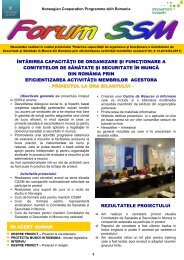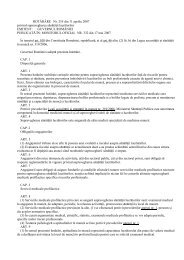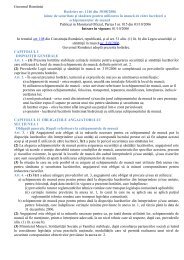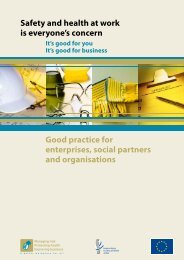Preventing work-related musculoskeletal disorders - European ...
Preventing work-related musculoskeletal disorders - European ...
Preventing work-related musculoskeletal disorders - European ...
Create successful ePaper yourself
Turn your PDF publications into a flip-book with our unique Google optimized e-Paper software.
<strong>Preventing</strong> <strong>work</strong>-<strong>related</strong> <strong>musculoskeletal</strong> <strong>disorders</strong><br />
• establishing Health Care Surveillance to ensure early detection<br />
and treatment of <strong>musculoskeletal</strong> <strong>disorders</strong>;<br />
•<br />
establishing Health Care Management programmes to encourage<br />
the return of affected employees to active participation in<br />
<strong>work</strong>ing life;<br />
• monitoring the prevalence of WMSDs and the effectiveness of<br />
the measures that have been introduced to prevent them;<br />
•<br />
developing job design methods that identify potential problems<br />
and eliminate them before new <strong>work</strong>ing methods and equipment<br />
are introduced to the <strong>work</strong>place.<br />
RISK ASSESSMENT<br />
A key stage in the above frame<strong>work</strong> is the systematic approach to<br />
Risk Assessment. Risk Assessment should be based upon the<br />
application of ergonomics principles and this approach is implicit in<br />
many of the existing <strong>European</strong> Union Health and Safety Directives<br />
(e.g. Manual Handling of Loads, Display Screen Equipment). It<br />
recognises the need to consider the <strong>work</strong> system as a set of<br />
interacting elements, with a strong focus on the needs and capacities<br />
of the <strong>work</strong>ers (or equipment users) in relation to the demands that<br />
are placed upon them by the performance of <strong>work</strong> activities.<br />
A variety of methods have been developed to assess the exposure of<br />
<strong>work</strong>ers to risk factors for <strong>musculoskeletal</strong> <strong>disorders</strong>, some of which<br />
have been specifically developed for use by practitioners in the<br />
<strong>work</strong>place (such as the Quick Exposure Check, Li and Buckle, 1998).<br />
The Risk Factors associated with specific activities and tasks that<br />
make up the job must be identified, and increased exposure to risk<br />
factors can be used as a basis for establishing priorities for action.<br />
Although the need to consider the interactions between potential<br />
risk factors is desirable, their separate assessment in the <strong>work</strong>place<br />
may well provide important pointers to potential areas for risk<br />
elimination or reduction. Those <strong>work</strong>ers in extreme exposure groups<br />
should be specifically targeted in the first instance for risk<br />
removal/reduction. It has been shown that ergonomics interventions<br />
to reduce the occurrence of WMSDs are likely to be particularly<br />
effective for occupations that are highly exposed to <strong>work</strong> risk factors<br />
(Hagberg and Wegman, 1987).<br />
GOOD PRACTICE<br />
The application of this approach to assessing or reducing the risks of<br />
<strong>musculoskeletal</strong> <strong>disorders</strong> in specific <strong>work</strong>ing situations has been<br />
illustrated on the following pages by a series of case studies. They<br />
provide an insight into the methods and solutions that have been<br />
used across a variety of <strong>work</strong>places and provide encouragement to<br />
those who wish to initiate prevention programmes. However, it is<br />
important to recognise that the solutions that have been advocated<br />
may not necessarily be effective in other situations where a different<br />
combination of <strong>work</strong>ing conditions, tasks, environments and<br />
equipment are found (i.e.<br />
different <strong>work</strong> systems).<br />
Action must only be<br />
Action must only be<br />
undertaken following a undertaken following a<br />
systematic risk assessment<br />
systematic risk assessment. at the <strong>work</strong>place<br />
concerned.<br />
A number of studies on the effectiveness of ergonomics<br />
interventions have been reviewed by Westgaard and Winkel (1997).<br />
They conclude that “the following intervention strategies have the<br />
best chance of success:<br />
• organisational culture interventions with a high commitment<br />
from stakeholders, utilizing multiple interventions to reduce the<br />
identified risk factors;<br />
• modifier interventions, especially those that focus on <strong>work</strong>ers at<br />
risk, using measures that actively involve the <strong>work</strong>er.”<br />
Both strategies incorporate the identification and the<br />
removal/reduction of the relevant risk factors for the exposed<br />
individual. “Accordingly, the active support and involvement of the<br />
individual at risk and other stakeholders in the organisation should<br />
be ensured.”<br />
There is a need for more information on the effectiveness of the<br />
measures taken in reducing the level of <strong>disorders</strong> within the <strong>work</strong>ing<br />
population. Organisations who undertake prevention programmes<br />
should be prepared to document a number of measures with respect<br />
to changes in the prevalence of <strong>disorders</strong> and variations in<br />
productivity both prior to and following the changes that are made.<br />
However, it must be recognised that staff within organisations often<br />
find such data difficult to collect and analyse for a number of<br />
practical reasons.<br />
The <strong>European</strong> Agency has established an information resource for<br />
practitioners, and especially those from SMEs, who wish to prevent<br />
WMSDs. It is the Topic Centre Good Practice on Musculoskeletal<br />
Disorders and provides detailed information on risk assessment and<br />
additional case studies. It may be found from the <strong>European</strong> Agency<br />
web pages at http://europe.osha.eu.int/good_practice/risks/msd/.<br />
REFERENCES:<br />
1 Li, G and Buckle, P (1998)<br />
A practical method for the assessment of <strong>work</strong>-<strong>related</strong> <strong>musculoskeletal</strong> risks – Quick<br />
Exposure Check (QEC)<br />
Proceedings of the Human Factors and Ergonomics Society 42ndAnnual Meeting<br />
5-9 October, Chicago, Illinois, v2, 1351-1355<br />
2 Hagberg M and Wegman, DH (1987)<br />
Prevalence rates and odds ratios of shoulder-neck diseases in different occupational<br />
groups.<br />
British Journal of Industrial Medicine, v44, 602-610<br />
3 Westgaard, RH and Winkel, J(1997)<br />
Ergonomic intervention research for improved <strong>musculoskeletal</strong> health: a critical<br />
review<br />
International Journal of Industrial Ergonomics, v20, 463-500<br />
<strong>European</strong> Agency for Safety and Health at Work<br />
27








